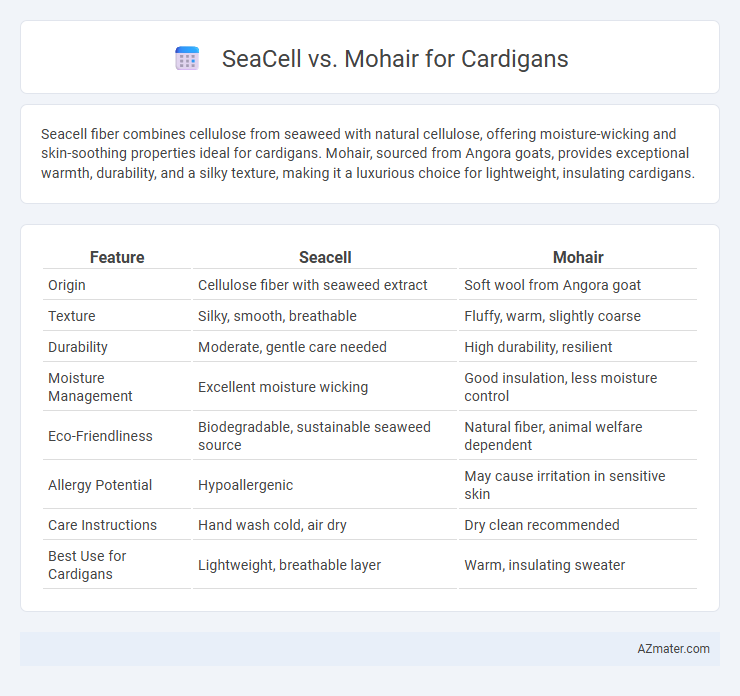Seacell fiber combines cellulose from seaweed with natural cellulose, offering moisture-wicking and skin-soothing properties ideal for cardigans. Mohair, sourced from Angora goats, provides exceptional warmth, durability, and a silky texture, making it a luxurious choice for lightweight, insulating cardigans.
Table of Comparison
| Feature | Seacell | Mohair |
|---|---|---|
| Origin | Cellulose fiber with seaweed extract | Soft wool from Angora goat |
| Texture | Silky, smooth, breathable | Fluffy, warm, slightly coarse |
| Durability | Moderate, gentle care needed | High durability, resilient |
| Moisture Management | Excellent moisture wicking | Good insulation, less moisture control |
| Eco-Friendliness | Biodegradable, sustainable seaweed source | Natural fiber, animal welfare dependent |
| Allergy Potential | Hypoallergenic | May cause irritation in sensitive skin |
| Care Instructions | Hand wash cold, air dry | Dry clean recommended |
| Best Use for Cardigans | Lightweight, breathable layer | Warm, insulating sweater |
Introduction to Seacell and Mohair for Cardigans
Seacell is an innovative, eco-friendly fabric made from a blend of cellulose fibers infused with seaweed, known for its softness, breathability, and skin-nourishing properties, making it ideal for cardigans that prioritize comfort and sustainability. Mohair, derived from the Angora goat, offers exceptional warmth, durability, and a lustrous sheen, creating luxurious and long-lasting cardigans with a distinctive texture. Both materials bring unique benefits to cardigan design, balancing environmental consciousness with timeless elegance and functional performance.
What is Seacell? Overview and Properties
Seacell is an innovative fabric blend made from regenerated cellulose fibers infused with seaweed, offering unique skin-nourishing properties and natural moisture retention. Its antibacterial, anti-inflammatory, and eco-friendly characteristics make it an excellent choice for cardigans, providing softness, breathability, and gentle skin benefits. Compared to mohair, which is prized for its luxurious warmth and fluffy texture but can sometimes cause irritation, Seacell cardigans deliver sustainable comfort and added wellness advantages.
Understanding Mohair: Key Features and Benefits
Mohair, derived from the Angora goat, is prized for its exceptional softness, sheen, and insulating properties, making it an ideal fiber for cozy cardigans. Its natural elasticity and durability ensure garments resist wrinkles and maintain shape over time, while the lustrous fibers provide a luxurious, lightweight feel. Moisture-wicking and breathable characteristics of mohair also contribute to comfort, making it a valuable choice for versatile layering in various climates.
Comparing Sustainability: Seacell vs Mohair
Seacell fibers, derived from sustainably harvested seaweed combined with organic cotton, offer renewable, biodegradable, and skin-friendly benefits, making them an eco-conscious choice for cardigans. Mohair, sourced from Angora goats, involves animal welfare concerns and higher water and land use, though it is naturally biodegradable and durable. Choosing Seacell over Mohair significantly reduces environmental impact through lower resource consumption and ethical production practices in cardigan manufacturing.
Warmth and Insulation: Which Material Performs Better?
Seacell fiber, infused with seaweed extracts, offers moderate warmth and moisture-wicking properties suitable for transitional weather, while mohair, derived from the Angora goat, excels in insulation due to its hollow fibers, trapping heat effectively. Mohair cardigans provide superior thermal regulation and a lightweight warmth that outperforms Seacell in cold conditions. For optimal insulation, mohair remains the preferred choice for warmth retention in cardigans.
Softness and Comfort: Seacell vs Mohair
Seacell fibers offer exceptional softness and breathability, making cardigans comfortable against sensitive skin with natural moisture-wicking properties. Mohair, derived from the Angora goat, provides a luxurious, silky texture that delivers warmth and a smooth feel but can sometimes cause slight itchiness for sensitive wearers. Choosing between Seacell and Mohair for a cardigan depends on whether you prioritize breathability and hypoallergenic softness or durable warmth and a plush hand feel.
Durability and Longevity of Seacell and Mohair Cardigans
Seacell cardigans offer exceptional durability due to their cellulose fibers derived from seaweed, which resist wear and maintain fabric integrity over time. Mohair cardigans, made from the long, strong fibers of the Angora goat, provide excellent resilience and retain their shape and softness even with frequent use. Both materials ensure longevity, but Seacell's natural bioactive properties help prevent fabric degradation, making it a superior choice for sustained durability in cardigan wear.
Care Instructions: Maintenance for Seacell and Mohair
Seacell cardigans require gentle hand washing in cold water with mild detergent, avoiding wringing or twisting to maintain fabric integrity and softness. Mohair cardigans demand careful hand washing or dry cleaning, with a focus on preventing felting and matting by using gentle detergents and reshaping while damp. Both fabrics benefit from air drying flat away from direct sunlight to preserve their natural fibers and vibrant appearance.
Skin Sensitivity: Hypoallergenic Qualities Compared
Seacell fabric, derived from seaweed fibers, offers natural hypoallergenic properties ideal for sensitive skin, reducing irritation and promoting skin health. Mohair, sourced from Angora goats, can sometimes cause itchiness or allergic reactions due to its coarse fibers, making it less suitable for highly sensitive individuals. Choosing Seacell cardigans ensures gentle comfort with breathable, antibacterial benefits, while mohair may require additional layering to prevent skin discomfort.
Which Is Better for Cardigans? Final Verdict
Seacell and mohair both offer unique qualities for cardigans, with Seacell providing eco-friendly, breathable fiber infused with seaweed extracts that promote skin health, while mohair delivers exceptional softness, warmth, and a luxurious sheen. For cardigans, mohair excels in insulation and durability, making it a preferred choice for cold-weather garments, whereas Seacell is better suited for those seeking sustainable, moisture-wicking, and hypoallergenic comfort. The final verdict depends on user priorities: mohair is better for warmth and luxury, while Seacell stands out for eco-conscious, breathable, and skin-friendly cardigan options.

Infographic: Seacell vs Mohair for Cardigan
 azmater.com
azmater.com